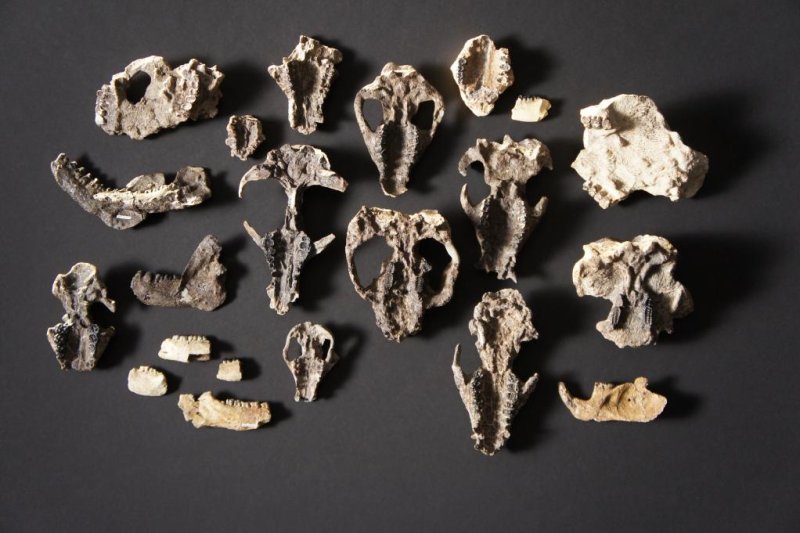Researchers in Colorado recovered hundreds of mammal fossils from a rock deposit representing the 1 million years after the extinction event that killed the dinosaurs. Photo by HHMI Tangled Bank Studios
Oct. 28 (UPI) -- Hundreds of well-preserved mammal fossils found inside a unique Colorado rock deposit have offered scientists an unprecedented look at what life was like during the first 1 million years after the extinction of the dinosaurs.
The fossil site was discovered in a place called Corral Bluffs, located in central Colorado. Within the bluffs, paleontologists discovered hardened concretions of stone housing the complete remains of at least 16 different mammal species, as well as the remains of turtles, crocodiles and plants.
Some 66 million years ago, a massive asteroid collision set off a series of cataclysmic events that wiped out the dinosaurs. In the wake of the mass extinction event, mammals rebounded and eventually thrived, but evidence of this mammalian renaissance has mostly come in bits and pieces -- leaving the nature and timing of these events relatively murky.
The extinction event marks what's known as the Cretaceous-Paleogene boundary, or K-Pg boundary. The boundary itself is well documented, but never before have scientists found such a wide-angled and high-resolution snapshot of the early Paleogene Period.
"Our site is different from all other localities known from this interval of time for two reasons," Tyler Lyson, curator of vertebrate paleontology at the Denver Museum of Nature and Science, told UPI in an email. "First, we had fossils preserved throughout our entire package of rock, approximately 1 million years, and not just in a handful of horizons, and second, the vertebrate fossils are much more complete than from any other locality."
In popular science, the giant asteroid that struck Earth -- and the mayhem that ensued -- is often characterized as a boon for mammals. But mammals, or at least mammal-like species, had been around for more than 100 million years when the K-Pg extinction event killed off the dinosaurs. The treasure trove of fossils at Corral Bluffs offers new clues as to how exactly mammalian life was impacted by the extinction event.
Mammals were affected by the asteroid impact, too. As the new fossils revealed, the largest mammals just after the event were no bigger than rats. Before, mammals as large as raccoons shared the planet with the dinosaurs.
But as the fossils found in layers farther above the K-Pg boundary revealed, mammals began to rebound and diversify without the threat giant dinosaurs.
Researchers used radiometric dating techniques and paleomagnetic techniques, the measure of magnetic polarity within the rocks, to date the time interval represented by the Coral Bluffs deposit.
"We flew the entire field area with drones to capture a photogrammetry model of the entire research area and super accurate Digital Elevation Model, which was used to place all of our fossils, plants and animals, into our timeline," Lyson said.
By precisely dating the different layers of the deposit, scientists were able to show that within 100,000 years of the K-Pg extinction event, mammals were once again racoon-sized. Within 300,000 years, some mammals had grown to the size of beavers. By 700,000 years after the extinction event, at least one mammal species, an herbivore named Ectoconus ditrigonus, weighed more than 100 pounds.
Among the thousands of fossil remains recovered from the Coral Bluffs site, scientists found several new species, as well as the most complete remains of previously described mammal species.
Researchers still aren't certain on what drove mammalian evolutionary patterns during the early Cretaceous.
"Our work doesn't shed much light on speciation or diversification other than to confirm that after mass extinctions we see adaptive radiations," Lyson told UPI. "After the K/Pg, both placental mammals and birds diversify. Our data helped determine how quickly the adaptive radiation occurred."
However, Lyson and his colleagues found evidence that the adaptive radiation of mammals in the wake of the K/Pg extinction event was closely tied to plant evolution. But despite this plant-fueled recovery, the latest findings -- published in the journal Science -- the planet's mammalian community was significantly affected by the asteroid impact.
Several archaic mammalian lineages failed to compete in the dino-free environs and slowly died off, while new types of mammals emerged. And even with the top of the animal food chain erased, it would take several million years more for mammalian evolution to produce large carnivores.















